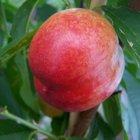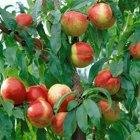Nectraine trees
Nectarine trees for sale from a specialist fruit tree nursery. Nectarine Trees can greatly broaden the repetoire of the amateur fruit grower; although previously though of as beyond the reach of an average gardener [hot house notwithstanding] it has been found that Peach and nectarine trees are actually perfectly hardy in all but the coldest areas. They are quite frost tolerant whilst dormant. With NectarineTrees you only need to watch out for late frosts which can damage the early flowers [which are by the way, highly beautiful
Nectarine Trees for Sale
Nectarine trees are universally self pollinating so there are no issues with pollination. They also tend to be conservative in growth – Peach and nectarine trees do not need the influence of a dwarfing rootstock to contain them and are generally incompatible on Pixy rootstock. Our Nectarine trees for sale are, therefore, grafted on to St Julien rootstock which gives good long-term results and will make a tree of up to 10′ in height. If you contain your Nectarine tree in a pot of 20-24″ this height will be less, and quite easy to manage.
Buy Nectarine Trees
Nectarine Trees can of course also be grown in a cold greenhouse, for extra reliability. They also thrive on a warm wall, a sunny south or west facing aspect will bring wonderful results. An area of 180cm’s x 180cm’s will be required if you wish to fan-train a Peach tree. One point to watch out for with growing Peach and nectarine Trees is that of leaf-curl which they will get if you do not take precautions. Although not fatal, and usually shrugged off as summer progresses, it is unsightly causing the leaves to blister. As the spores of this fungal disease are spread by water, the simplest way to stop the tree from getting it is to keep the foliage dry as it begins to emerge in spring.
Once the leaves are fully formed they arte out of danger. Trees in pots can simply be moved into a cold greenhouse or sun lounge for this period of a couple of weeks or so. Alternatively the disease can be thwarted by the application of a copper based fungicie in early spring – but this is a preventative measure, not a cure.

